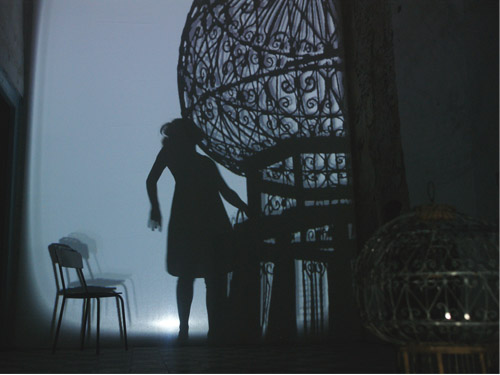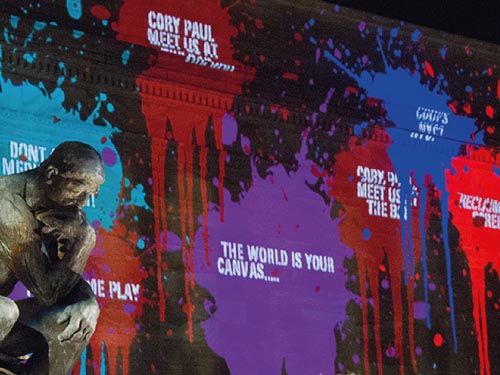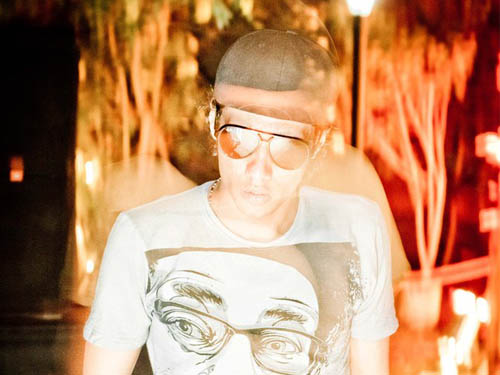
I met the 10 InterLAB/Tele-exhibition collaborators less than 48 hours after they had met each other for the first time — they have been working together for some months now, though. Until this past week, they had been communicating through Skype, emails, a wiki, Facebook and the strange interactive artworks that they have been creating together.
Five of the collaborators are Egyptians from various professional backgrounds, with an astrophysics teacher, a computer scientist and three artists. They have been working together in Cairo as OpenLabEgypt for the past few months. The other five are German computer scientists and artists who collaborate in Dresden.
The Germans, who are collectively known as Kazoosh!, have come to Cairo for 10 days to finalize their projects with OpenLabEgypt and exhibit them in the InterLAB/Tele-exhibition which opens tonight as part of the Downtown Contemporary Arts Festival, or D-CAF. Kazoosh! members have just seen Medrar for Contemporary Arts, a space they have come to know online, in person for the first time, and in it the remnants of an exhibition that they co-created in February.
Joanna Szlauderbach, the project coordinator on the Dresden side, says that “the creative process is so easy when you are sitting next to each other — it takes five minutes to make something that would take you years online.”
She describes the collaborators having a drink and watching a movie the night before and spontaneously discussing the nature of perception, in contrast to time differences and bad connections that plague online communication.
The collaboration between the two groups started as an online workshop.
Dia Hamed, the project coordinator on the Cairo side, met Kazoosh! in 2012 at CYNETART, an international festival for computer-based art in Dresden. He said the two groups, Kazoosh! and OpenLabEgypt, each emerged as like-minded people interested in doing similar things and started organizing together.
OpenLabEgypt started as a series of workshops in 2009 in collaboration with Hangar.org in Barcelona. Several interactive works were produced and exhibited by the end of the year at the Viennoise Hotel, which will also host part of the InterLAB/Tele-exhibition tonight.
Out of the 2009 workshops emerged the idea of establishing a media laboratory at Medrar as a platform for ongoing and more autonomous collaboration between people here. But work was ultimately put on hold because the very mediums and techniques were not “intuitive to the artists at the time” — a community of artist-techies had not emerged in Egypt, as Hamed explains.
With the InterLAB/Tele-exhibition, there has been a rebirth of OpenLabEgypt, but in a formation more lateral than hierarchical, Hamed says, suggesting this makes it both more enduring and more energetic. The technological aspects are much more accessible now, as well as ideas, because “the geeks,” as Hamed calls them — and here he refers to artists working in the medium as well as OpenLabEgypt — document everything and share it openly online, so you can learn on your own just by Googling.
A two-day InterLAB project was exhibited in February at Medrar’s Garden City space and simultaneously in Dresden. Hamed calls it a “communicative exhibition where audiences interact through the artworks.”
Each piece was made in a completely collective way. Hamed describes the journey each idea would take, from the initial inspiration in one person’s mind, to development in someone else’s hands, to be modified by a third collaborator, and so on.
The results were strange and playful, involving a mixture of low-tech and high-tech elements. The exhibition attendees in Cairo were communicating with people in Dresden, but each had no information about the person they were communicating with apart from that person’s input into the piece.
“It creates a strange kind of relationship,” said Hamed.
For one piece, participants in Cairo blew bubbles toward a screen and these somehow emerged as sounds in birdcages in Dresden. Meanwhile, a shisha was placed in Medrar’s balcony, and cables detecting the bubbles created in the shisha water each time someone inhaled sent signals to Dresden for bubbles to emerge from a bubble canon in the guise of a desk lamp. Another was a simple live stream of the space and audience in Dresden.
But one of the most magical elements of the exhibition was a photo booth, one in each location, where the face of a person in the other city replaces yours — “an exchange of facial deformities,” Hamed called it.
“You smile his smile, you raise his eyebrows, you blink his eyes,” he says. The resulting photos, which print out and emerge from the side just like in any normal photo booth, are, as Hamed describes them, “very spooky things.” He points out that they have also created documentation of everyone who attended the show, an archive that could be put to interesting use in the future.
Instead of two different countries, the exhibition for D-CAF will be held simultaneously in Medrar and the Viennoise Hotel in downtown Cairo. Two pieces will be reused from the previous show, and the other pieces will be new — including some still being worked out this week.
One of these new pieces sounds quite bizarre: through emotional recognition mechanisms, the viewer’s reaction to a film will modify that film, or determine what the next viewer sees. Hamed said the film itself, created purely in order to provoke extreme facial expressions, is going to be pretty unusual.
Another new piece will be a toy car carrying a video camera that will move around the exhibition in Medrar, but operated using a joystick in the Viennoise Hotel. Some site-specific works are still being developed, and the exhibition is certain to be full of surprises.
As for InterLAB’s future, they will be exhibiting some of the objects at ZKU in Berlin from 11–16 June, and are now applying to show the work at festivals in Istanbul and Italy. They are also applying for funding for the Egyptian artists to go to the next edition of CYNET art festival in November.
Kareem Osman, one of the Egyptian participants, says the group’s long-distance relationship fed into the artworks by constantly posing the question of “how to know people, what is the best way to make people interact when you do not have the same language or physical space?”
“The most important part of the whole process was the question, ‘What are the senses that we can transfer?’” Osman says, adding that smell and taste have proved to be the most difficult. “And what about what is beyond the senses? What about emotions?”
These are questions that are becoming increasingly important in today’s world.
InterLAB/Tele-exhibition opens on 6 April at 5 pm at Medrar for Contemporary Arts, 7 Gamal Eddin Abul Mahasen St., Garden City, and the Viennoise Hotel, 11 Mahmoud Basiony St. It continues until 28 April, Saturdays to Thursdays from 5–10 pm.
This piece was originally published in Egypt Independent's weekly print edition.




